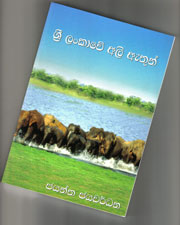Jayantha Jayawardena (JJ) is a name synonymous with elephants. An expert on Asian elephants, his writings on elephants are considered authentic and authoritative. For the benefit of Sinhala readers he has written a most interesting book titled, 'Sri Lankave Ali Athun' (Elephants in Sri Lanka).
Illustrated with drawings and photographs, the book has a wealth of information on elephants written in a most readable easy style which attracts even the average reader who may not be that interested in elephants. I myself fall into that category -- though I would take a good look when I see an elephant on the road or during an occasional visit to a national park--I wouldn't go out of my way looking for them.
The book, however, was a fascinating read. I learnt a lot on the history of our (Sri Lankan) elephant—its physical characteristics, behaviour as well as the threats faced by the elephant population. JJ has also not ignored the burning issue of the day - the conflict between elephant and man.
 |
JJ begins with historical facts touching on elephants as a whole and moving on to discuss the features of the African elephant (Loxodonta Africana) and the Asian elephant (Elephas maximus). The former weighing around six tons, is found in more than 30 countries in the African continent whereas the latter, weighing around four tons, lives in just 13 countries of the Asian continent. While the estimated population of the African elephant is between 600,000 and 700,000 there are not more than 35,000 to 55,000 Asian elephants. The author details the physical characteristics of both.
JJ believes that people in Sri Lanka had contacts with elephants about 5000 years ago. He identifies Navalar Kulam area in Panam Pattu in the Eastern Province as the first location where there is inscriptional evidence of contact between elephant and man as far back as the 1st century BC. The inscription describes a religious ceremony conducted by a prince who was in charge of elephants. The tradition of using elephants for religious ceremonies continues to this day, particularly with their participation at processions held by temples and devales.
Elephant fights - 'Gaja keliya' - had been a popular item at sports festivals in the early days. And they had played a vital role in ancient battles. They were used to transport heavy equipment to the battle field and to smash up obstacles blocking the roadways. They were very much part of the armed forces. There were elephants especially trained to fight the enemy using heavy iron chains fixed on to the trunk.
JJ states that unlike the Indian elephant, the Sri Lankan elephant had always been a disciplined animal and could be trained easily. Even the Greeks during the time of Alexander the Great (3rd century BC) had known of this.
The elephant was a profitable export commodity and there is reference to them being taken in boats from 'Mantai' (present day Mannar) to Kalinga around 200 BC. The export of elephants had continued even at the time the Portuguese occupied the maritime provinces in the 16th century.
There were trainers to train elephants during the days of the ancient kings. They hailed from Kegalle and belonged to a community known as 'kuruwe'. Their task was to catch elephants from the jungles and train them for royal service. They also trained the mahouts. The dwindling of the elephant population in Sri Lanka, according to JJ, began when elephant- hunting became a sport during British times. It is on record that Major Rogers, an officer in the British forces had killed over 1500 elephants within four years - virtually an elephant a day. Two others - Captain Gallwey and Major Skinner had each killed half that number. Ironically, when he was 41, Major Rogers was struck by lightning while in the verandah of the Haputale rest house and was killed. His tombstone at the Nuwara Eliya golf links had been broken down twice struck by lightning.
The colonial administration had supplied guns free of charge to the cultivators to protect their crops from being destroyed by elephants. The cultivators who used to protect their crops using traditional methods now had a tool in their hands by which they could easily kill the elephants. The same thing happened in the plantation areas when while clearing the forests to plant coffee and tea, elephants were killed in their numbers. At the same time they used the trained elephants to pull down huge trees and transport heavy material for construction work.
Administration Reports state that between 1853 and 1884, 2,890 elephants had been exported. By that time the Malays and Muslims living in the Mannar district and in the Eastern province were used to catch elephants. The elephants were exported from Mannar. Those who were caught in the South were sent from the Galle harbour. Gradually the numbers came down. During 1890-94, only 171 elephants had been exported.
Due to the opening of plantations in the 19th century, the elephant population in the hill country dwindled and JJ says that only very small herds can be seen in a few places today.
JJ then moves on to discuss the physical characteristics of elephants and how one can differentiate a male from a female. |


